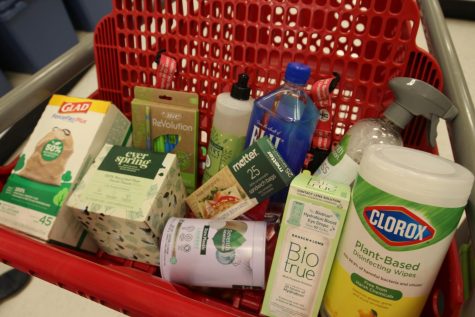Greenwashing: Eco-friendly products aren’t as friendly as they seem
‘Eco-conscious’, ‘environmentally friendly’ and ‘sustainable’ are all labels that are printed on multitudes of products these days.
With consumers becoming more and more concerned about protecting the environment, corporations have followed with claims to meet those concerns. But is it all a scheme to make their products and practices sound more sustainable to make more profit?
What is greenwashing?
According to Earth.org, greenwashing is when a company or corporation spends more money and effort to make their products sound more sustainable than actually minimizing their environmental impact. It is a form of deceptive advertising to gain favor from customers who are trying to help the environment. It takes attention away from the real root causes of climate change.
“Greenwashing specifically addresses the fact that oftentimes it turns out that this product is not actually better for the environment,” said Dr. Jennifer Kahn, AP environmental science teacher and ECOS adviser.
In addition, according to Investopedia, greenwashing may occur when a company tries to overemphasize the sustainable parts of their practices while they are actually engaging in very damaging environmental practices. It is performed through packaging, misleading labels and environmental imagery.
Greenwashing takes up valuable space in the fight against climate change and according to Earth.org, can distract us from positively fighting the crisis.
How does greenwashing work?
Most recently, many of the world’s biggest carbon emitters have attempted to rebrand some of their popular products into “green alternatives.” These products undergo a transition that may include renaming, rebranding, or repackaging them.
Usually, greenwashed products are packaged in bright green packaging and may include marketing terms like ‘natural,’ ‘wholesome,’ or ‘free of chemicals.’ But basic terms like these are not backed up by any organization or company. Companies can use these claims on their packaging regardless of their actual environmental practices.
Vivid imagery is also popular, with many greenwashed products including leaves, plants and happy animals. This is more deception used to confuse consumers into believing the product is eco-friendly.
Companies also commonly cherry-pick information to sound the most sustainable while leaving out important context that may contradict those claims. For example, a product may claim to be cruelty-free but has a high carbon footprint. Many corporations will do everything they can to hide their actual practices in protecting the environment.

(Ash Magalhaes)
Why do companies engage in greenwashing?
With the rise in attention to caring for the environment, companies have realized that claiming their products to be environmentally ethical drives profitability.
A recent study conducted by First Insight on shopping habits showed that consumers – across all generations – are now willing to pay more for sustainable products.
Take Gen X for example; just under three years ago only 34 percent of the generation said they would spend an extra 10 percent on a product’s price. Today, nearly 90 percent of Gen X customers are willing to spend extra on more sustainable products.
“A lot of consumers want to make good sample choices for the earth,” said Dr. Kahn. “If they think that they have a choice between two products where one of them is more environmentally friendly, they might lean towards purchasing that product.”
This is reflected in the sustainable product market. According to a study published by TerraChoice, a global marketing company, the eco-friendly product market grew by 73 percent in the last 5-7 years as awareness has increased across the population.
“Right now in order to be ‘sustainable’ and to make the best possible choices, that’s going to mean that you’re paying more [for a product] as a consumer,” said Dr. Kahn.
Popular greenwashing cases
Many large corporations are behind many of the greenwashed products you see in stores today.
One large greenwashing case was Tide PurClean laundry detergent, which was a “green” alternative to the iconic Tide detergent that has been around for many years. The bottle has everything that a greenwashed product has, including a green bottle, leaves on the sticker, and a spiffy natural name.
The description on the bottle itself quoted “A powerful, plant based clean you can feel good about.”
But, according to Truth in Advertising, only 75 percent of the detergent was plant-based. The other 25 percent consisted of non plant-based ingredients, including petroleum, a form of oil.
“Consumers need to have confidence that what it says on the label is actually what they’re buying,” said Dr. Kahn. “That’s the problem I know needs to be addressed.”
In Aug 2020, The National Advertising Division recommended that Tide alter their claims on the packaging. Now, the bottle reads “Plant Based” with an asterisk citing that 75 percent of the ingredients are plant-derived.

Another company accused of greenwashing is the popular fast-fashion company H&M. Inherently, fast fashion is bad for the environment according to Good Housekeeping. It drives rapid overconsumption of clothing because it generally goes in and out of style quickly, causing consumers to throw away or donate their clothes when they go out of style.
H&M is being met with harsh criticism over the fact their business revolves around fast-fashion. To respond to the criticism they introduced “conscious choice” products with environmental scorecards to make people less guilty about buying fast fashion. These scorecards rated the products on scales like fossil fuel use and water use.
According to a report from Quartz, however, these scorecards were outright deceptive and generally misleading. More than half of the scorecards claimed the products were more sustainable when in actuality the product was no better for the environment when compared to its competitors.
In some extreme cases the scorecards actually showed the exact opposite, with some products actually being worse for the environment despite the “conscious choice” moniker.
How to avoid greenwashing
Greenwashing can be very hard to avoid, especially because it can be hard to know and understand the minute details about every product.
“I don’t think it’s reasonable to ask an average consumer to look up every single product that they buy,” said Dr. Kahn.
However, in a sea of unregulated terms like “low-waste” and “eco-friendly” there are certain labels that are backed up by government or independent organizations.
According to Common Market, labels like USDA certified organic, FSC certified, Rainforest Alliance Certified, Fair Trade certified and more are a good sign that the product is not greenwashed. These labels are only put on products that meet the requirements of the certification.
“Be skeptical about claims that companies make on their products,” said Dr. Kahn. “Do your research on items that you’re either spending the most money on or buying most frequently.”






![Senior River Thompson joins the Jazz Ensemble by singing “That Old Black Magic” by Mercer and Arlen Arr. Mark Taylor, along with senior Annie Brody on guitar and junior Thomas Teixeira on bass, earning big applause. “[The concert had] great energy because it's the last [jazz concert] of the year,” Brody said.](https://www.lhsdoi.com/wp-content/uploads/2025/04/Eight-That-Old-Black-Magic-600x400.jpg)
![Mr. Abullh Ali, manager/assistant, helps open Queen Yemeni Coffee in downtown Libertyville at 606 North Milwaukee Ave. With the help of employees such as manager and LHS senior Yousef Taha, they are able to bring the Yemeni and Ethiopian culture to Libertyville by using their Queen spices, cinnamon and cardamom in their drinks such as Adani Chai, which is inspired by Sheda, the Queen of Yemen and Ethiopia. “The history of our coffee [is] a long history and we believe that Yemen and Ethiopia started the coffee and we are bringing something unique to the community,” Mr. Ali said.](https://www.lhsdoi.com/wp-content/uploads/2025/04/Photo-1-600x400.jpg)


